Pivot Shuttle SL/AM
Wheel Size: 29” (Size XS: 29” front / 27.5” rear)
Suspension Travel:
- Frame: 150 mm
- Fork: 160 mm
Geometry Highlights:
- Sizes offered: XS, S, M, L, XL
- Headtube angle: 64.1° (Low)
- Seat tube angle: 76.5° (Low)
- Reach: 476 mm (Low)
- Chainstay length: 444 mm (all sizes)
Drive System Highlights:
- Motor: Bosch Performance Line SX
- Power: 600 watts
- Torque: 60 Nm
- Assist percentage: 400%
- Battery: 400 Wh
- Display: Bosch System Controller
Frame Material: Carbon Fiber
Price: Complete bikes: $8,499 to $15,098
Blister’s Measured Weight (Pivot Shuttle SL/AM Pro XO Eagle Transmission, size Large): 42.8 lbs / 19.4 kg
Test Locations: Colorado, New Mexico
Reviewers:
- Dylan Wood: 5’10.5”, 160 lbs / 179 cm, 72.5 kg
- Simon Stewart: 6’, 170 lbs / 183 cm, 77.1 kg
Test Duration: 5 months

Intro
There has been a recent trend of lighter-weight full-power eMTBs spec’d with smaller batteries, with the option of supplementing the smaller battery with a range extender for longer rides. The idea is to give you a lighter bike for hot laps on your local trail system, and with the addition of more watt hours from the range extender, one that can potentially match full-power eMTBs with larger batteries in range for bigger rides.
But, here’s the rub: that approach usually only saves 3–5 lbs, with bikes typically still weighing 45–48 lbs. Pivot didn’t think that juice was worth the squeeze because they were after something more like 10 lbs lighter, yet with more power than light-assist eMTBs running drive systems like the TQ HPR 50 or Fazua Ride 60 (like their Shuttle SL). Enter the Bosch SX drive system. It has peak power that matches their full-power CX motor, and in combination with the 400 Wh battery, has a total system weight that is actually slightly lighter than the Fazua system, and only a small bit heavier than the TQ system.
But the drive system is only part of the story. In addition to lighter weight and more power, Pivot also wanted the All Mountain capability found in their Shuttle AM. So they essentially have given the Shuttle AM a motor swap, and in doing so, they’ve made the Shuttle SL/AM considerably lighter than the AM (it’s claimed to be almost as light as the Shuttle SL). Let’s dig in and check out what Pivot has come up with.
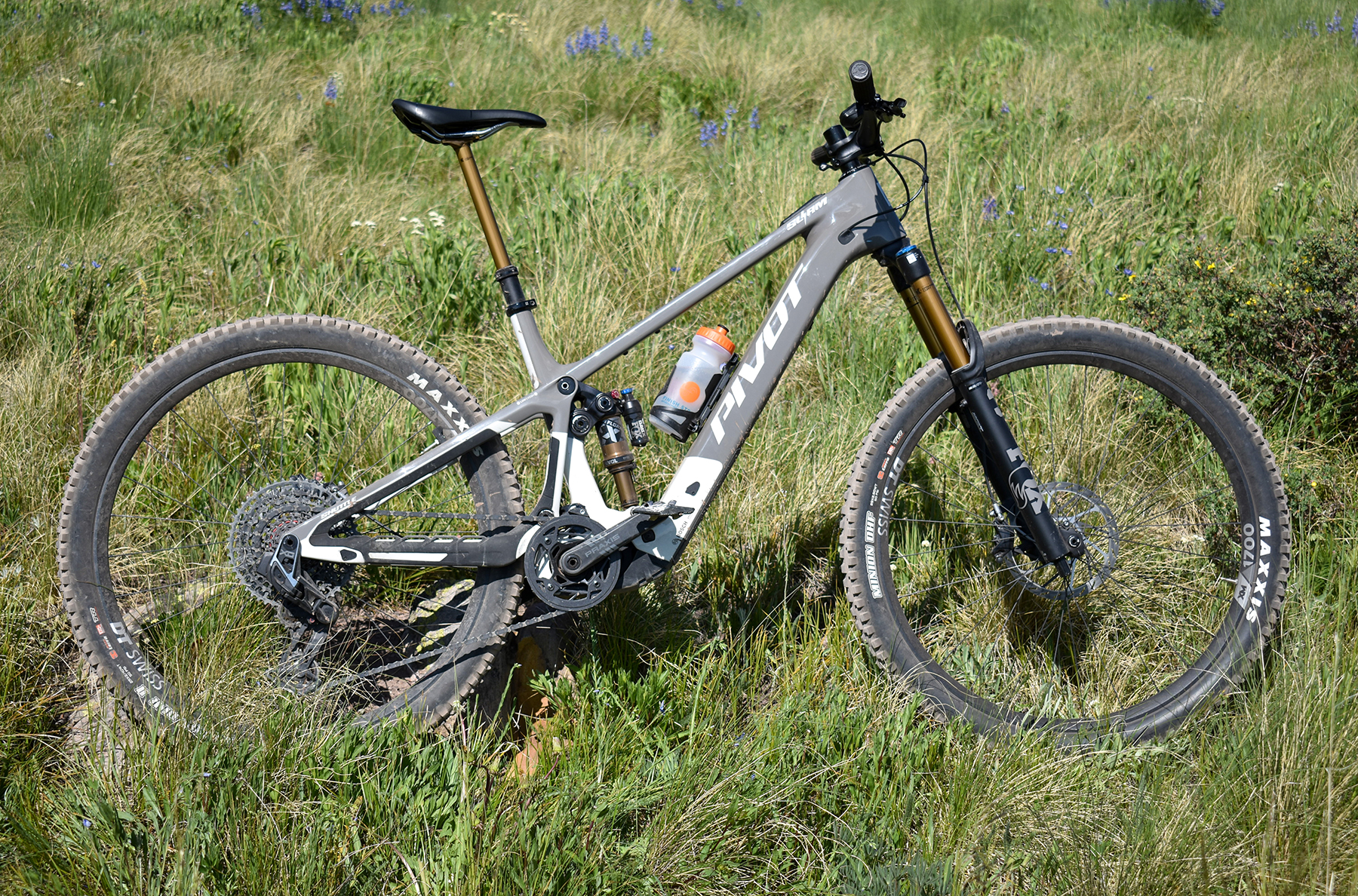
The Frame
The Shuttle SL/AM frame strongly resembles the Shuttle AM’s frame. A sharp eye may detect the slightly different profile of the SX motor versus the CX motor, but overall, it’s pretty much indistinguishable. I find the Shuttle SL, AM, and LT to be good-looking bikes, and the same holds for the SL/AM — I love the way the seat stays follow the same slope as the top tube, forming a straight line from the head tube back to the rear axle, creating a silhouette that looks fast standing still.
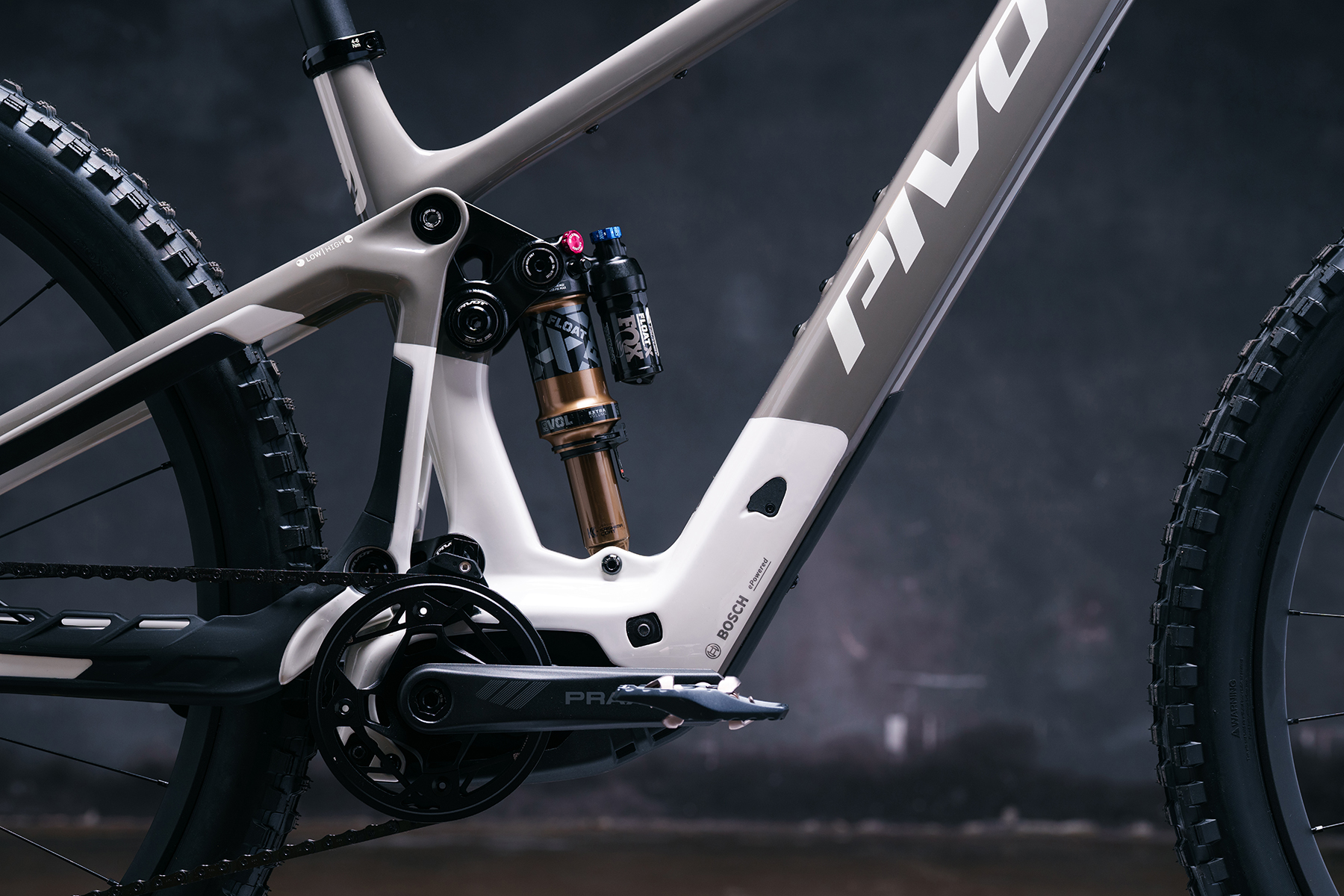
The Shuttle SL/AM has 150 mm travel from Pivot’s typical DW-Link layout. Pivot states that the DW-Link design provides the optimal amount of anti-squat to manage the additional power output of the drive system. They also claim the kinematics have been enhanced to deliver an efficient pedaling response when climbing, and control when descending. Pivot hasn’t supplied any suspension kinematic graphs, so we can’t comment on specific numbers. Like the Shuttle AM, the Shuttle SL/AM also incorporates a flip chip to adjust the bottom bracket height. Swapping from Low to High raises the Bottom Bracket by 5 mm, steepening the seat and head angles by 0.4 degrees. The flip chip also makes the Shuttle SL/AM mixed-wheel-size (MX) compatible. With the flip chip in the High position and a 27.5” rear wheel, Pivot says the geometry numbers are very close to the 29” rear wheel with the flip chip in the Low position, including the head tube angle, which is only 1/4º slacker in the mixed wheel size configuration. (They don’t have a separate geometry chart for the MX setup, though.) All bikes will ship in the Low position.
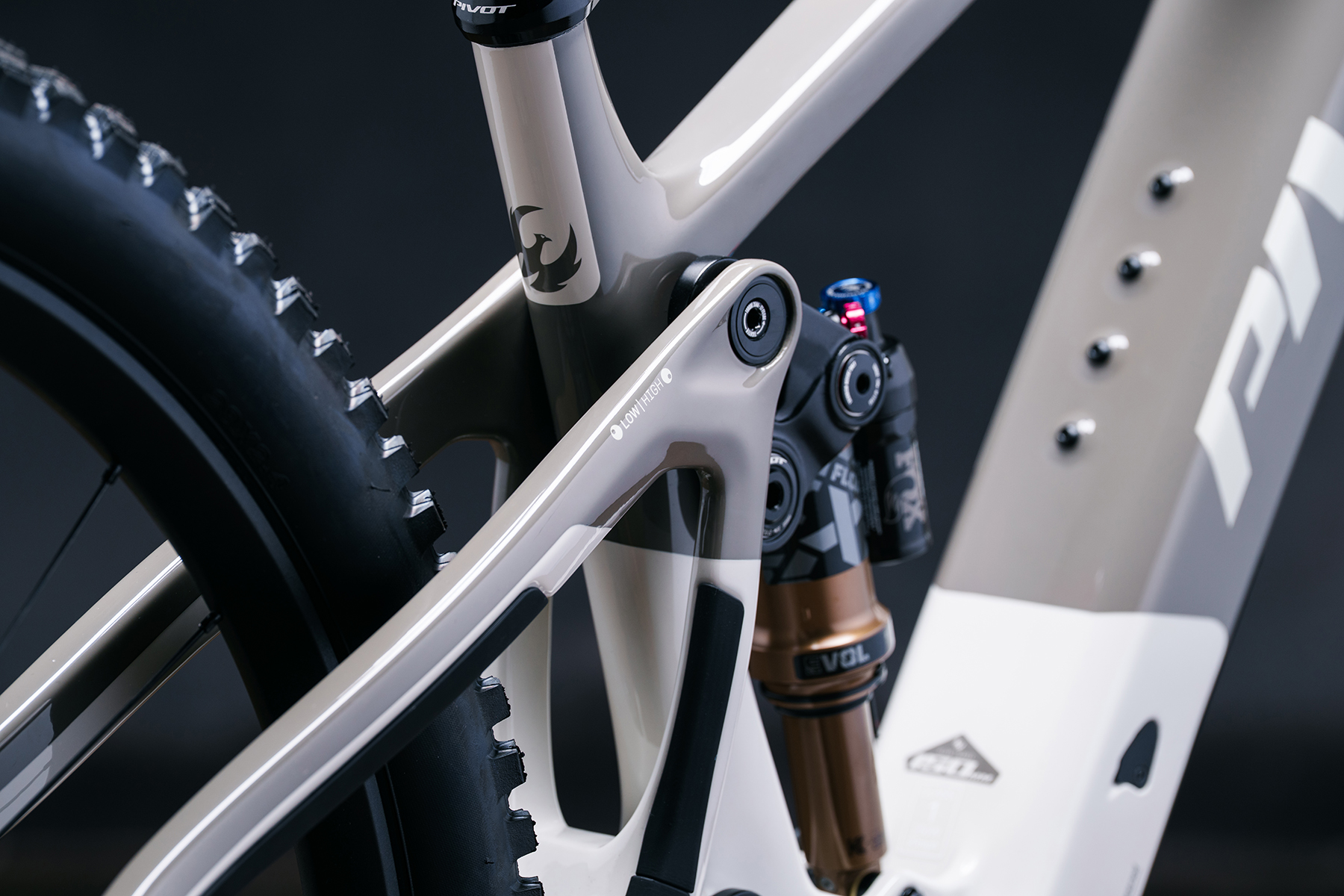
Pivot claims the secret sauce to making their desired ride characteristics consistent throughout the size range is the effort they put into manipulating the carbon layup and tube thickness to achieve their preferred balance of flex and stiffness for each respective size.
The Shuttle SL/AM frame has room for a full-size water bottle, even on the size XS (thanks to swapping in a Fox Float inline shock instead of the Float X reservoir shock used on the other sizes). Rear wheel spacing is Pivot’s preferred 157 mm Super Boost, and of course, the swingarm incorporates SRAM’s UDH. Frame protection looks good with a thick pad in front of the motor and protection on both the seat stays and chainstays. The Shuttle SL/AM features a new cable port design that allows two cables to be routed through the same port. The new design is said to make it easier to route the cables, while also being more adaptable to custom setups like moto-style routing.
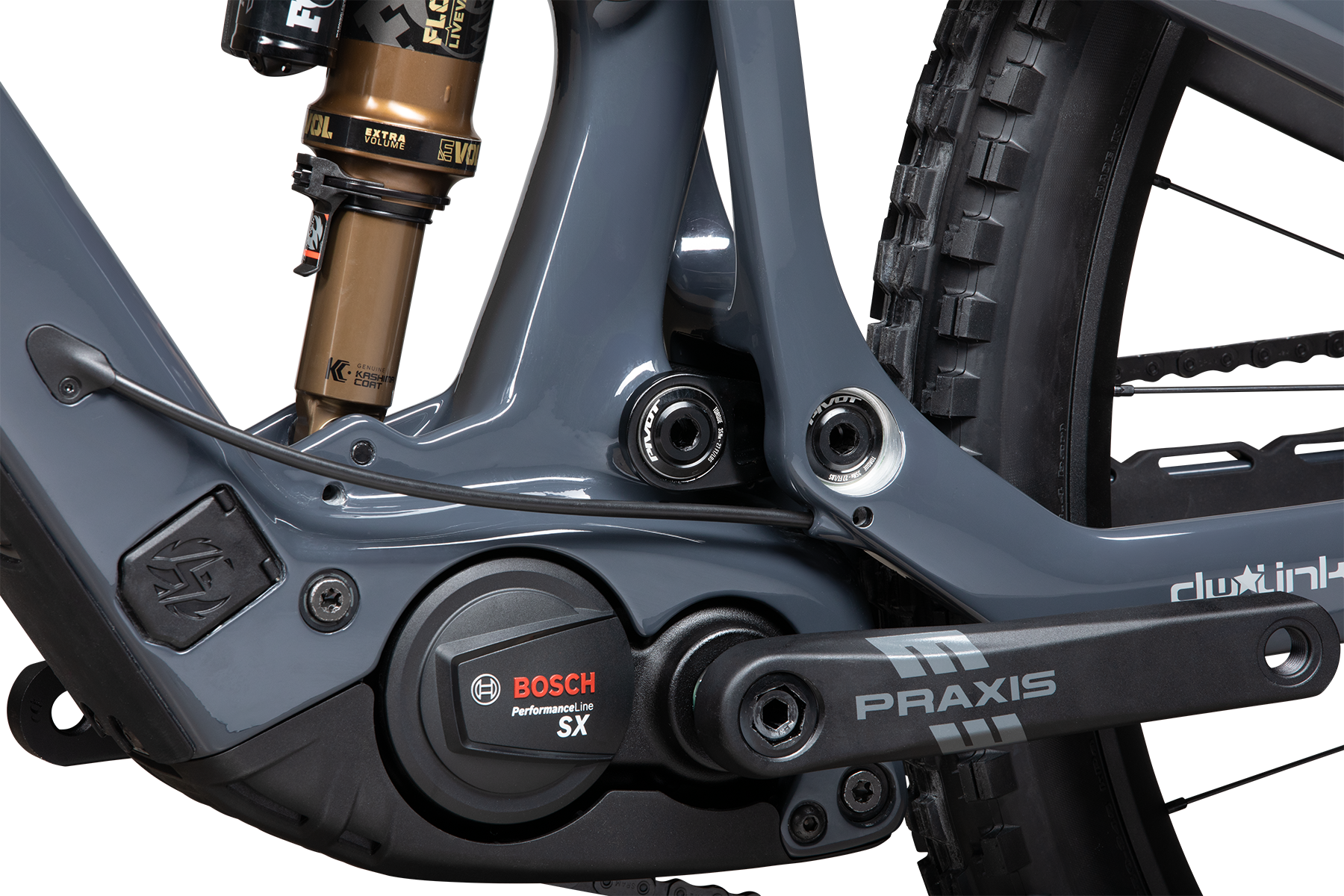
Drive System
Bosch’s Performance Line SX has been out since June ‘24, and we’ve had plenty of opportunity to spend time on it on various eMTBs. It quickly became a favorite due to its lightweight and spunky nature. But, while its peak power matches the full-power CX motor, we found the lower torque output (55 Nm versus 85 Nm) makes it challenging (but not impossible) to keep up with full-power eMTBs. Additionally, even though the SX motor is claimed to be a good bit more efficient than the CX motor, the 400 Wh battery can’t match full-power eMTBs with batteries 600 Wh or bigger for range. With that said, we like that you have to put in more effort to realize the full power potential of the SX, and we also appreciate how light it is and the positive effect that has on handling.
Weight is a major consideration for drive systems in this category, and the claimed combined weight of 8.8 lbs / 4 kg for the motor and battery of the Bosch SX is competitive. Fazua claims a total system weight including remote and display of 9.2 lbs / 4.2 kg. The TQ drive system, on the other hand, is still the lightest at 8.6 lbs / 3.9 kg (including display and remote), but it also has the lowest power and smallest battery.
Bosch states the weight savings (over the full-power motor) are the result of a more compact design, optimized crankshaft, and a magnesium housing.
What really stands out for the SX motor is its max power of 600 watts. This is the same max power as their full-power motors (before installing the new Bosch performance software upgrade). There is a caveat, though, because the motor produces less torque (55 Nm vs 85 Nm), and since power is the product of torque and cadence, that 600 watts comes at a significantly higher cadence than the full-power motor. We like that it makes the rider work for the full 600 watts and find it to be really engaging trying to wring the maximum power out of it, but also find the required high cadence can compromise technical climbing performance.
Both the Fazua and TQ drive systems claim to have no mechanical resistance when ridden unpowered, and having spent time on both systems, they do feel like it. The Bosch SX motor claims a 50% reduction in drag over their full-powered motors, but this means it will still have some mechanical resistance. In back to back testing with the TQ and Fazua motors, the TQ has the least resistance (almost undetectable), the Fazua is next with slightly more then the TQ, and the Bosch SX comes in with the most resistance of the three, but still noticeably lower then any full-power motor we’ve been on.
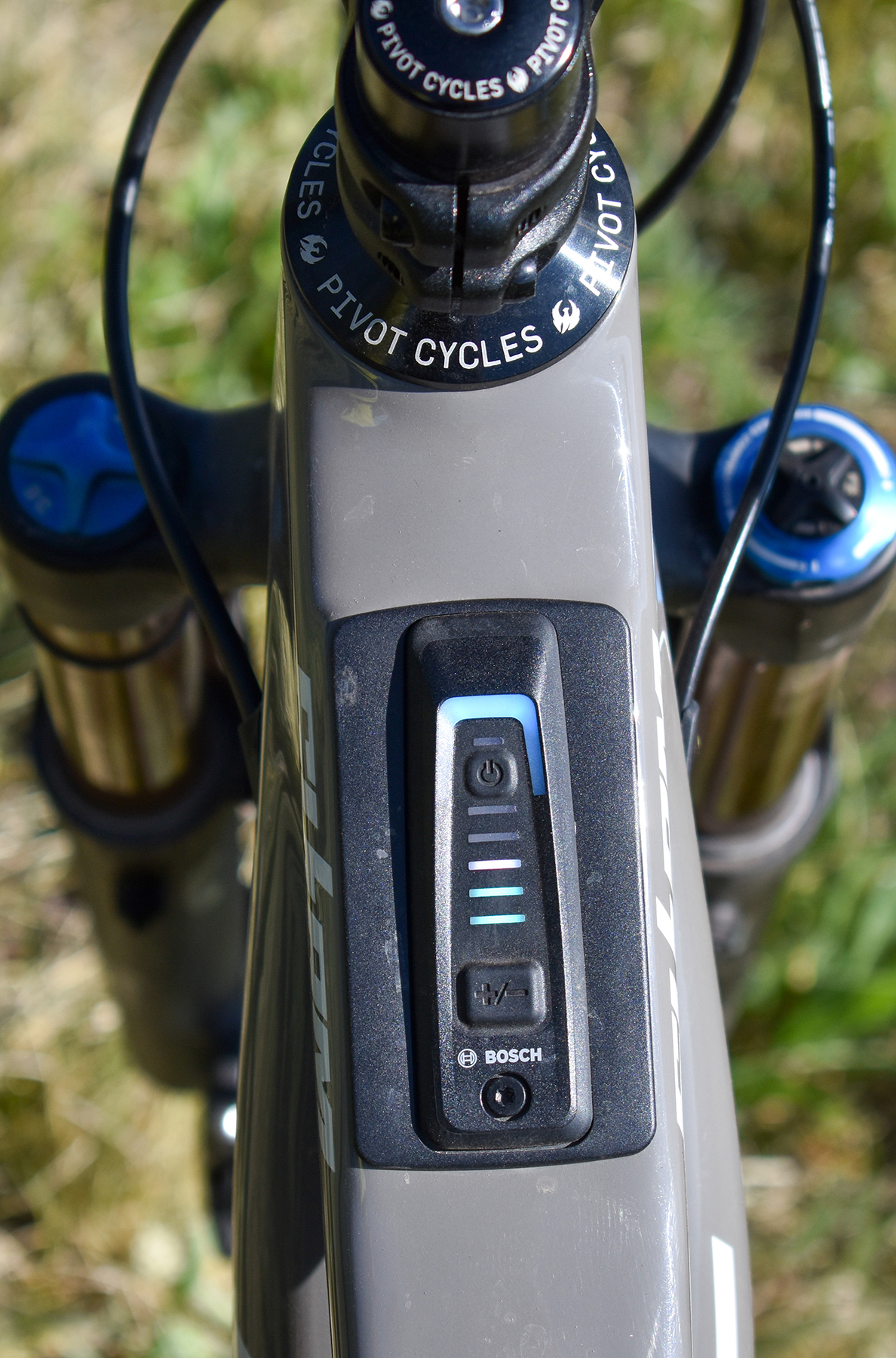
The wireless Mini Remote and System Controller are the same as what you get on other Bosch Performance Line drive systems. All three builds come equipped with Bosch’s integrated top tube System Controller, which displays basic information like assist levels and battery power. The display does not provide as much detailed information as other top tube displays like the Specialized Mastermind T3, TQ display, or Rocky Mountain’s Jumbotron.
However, Bosch has been clever by using different colors for assist levels and battery power that give the minimalist display added detail. For assist levels, four colors correspond to the different levels: green for Tour +, blue for Sport, purple for eMTB, and red for Turbo (assist levels can be customized in the eBike Flow app). For battery power; there are five LED bars, and each one of those bars turns from blue to white when that bar is below 50% — you end up with ten battery charge levels, and based on a full charge of 100%, you can determine to within 10% of what the remaining battery capacity is. When the charge is less than 30%, the bars are displayed in orange, and once it gets down to 10%, the last bar turns red.
Bosch has recently released the Kiox 400c, which is a full featured color integrated top tube display. It is compatible with the SX system, and the Shuttle SL/AM’s frame has been designed to accommodate its larger size. Bosch is notoriously slow to have recently released components available, so Pivot expects the new display won’t start being spec’d on the SL/AM till sometime next year.
However, should you decide to upgrade the display on your Shuttle SL/AM, and you’re able to find one, installing the new Kiox 400c display is an easy plug-and-play procedure. The new display finally puts Bosch on a level playing field with the competition.
In the meantime, Bosch’s eBike Flow app bridges the gap to more detailed information. It connects wirelessly to the bike via Bluetooth, and once paired, displays a custom Pivot interface that has all the information the top-tube-mounted display lacked, plus a whole lot more. Features include customizable assist levels, over-the-air update capability, maps, ride statistics, and a locking feature. The locking feature uses your smartphone as a virtual key, with the bike’s drive system automatically locked in the off position when you walk away from the bike, and unlocked once you (and your phone) are back in range.
Bosch has also recently updated the app to finally allow you to have more then one eMTB stored in the app. Previously, you had to delete the current bike in the app in order to add a new one; now you can have up to six bikes stored. I know, I know, this seems like the answer to a high-class problem only a bike reviewer would have…
There’s also the option to use your smartphone as a display, which gives you access to real-time data like speed, exact battery percentage remaining, maps, and range. Of course, you will need to mount your phone somehow, and Bosch does sell a mount called the SmartphoneGrip, but it is not integral, so you can use any of the myriad smartphone mounts available. Bosch also offers a variety of handle bar-mounted displays that are compatible, and are available as aftermarket accessories.
Pivot will be offering Bosch’s 250 Wh PowerMore range extender as an optional accessory. The PoweMore weighs 3.3 lbs (1.5kg), and fits in the water-bottle cage. Total system battery capacity goes up to 650 Wh with the range extender, which, thanks to the SX motors claimed efficiency, could give the Shuttle SL/AM the legs to match some full-power eMTBs for range.
Since Bosch just released details of an upcoming optional performance software upgrade for the current CX motor that gives it heaps more power (750 watts versus 600 watts), we’re curious if the SX motor may be next in line for some more power. We’ll have to wait and see, but more is always welcome.
Fit & Geometry
The Shuttle SL/AM is offered in five sizes: XS, S, M, L, and XL. The addition of the size XS is a first for Pivot for an eMTB. Not many brands offer eMTBs in a size XS, usually due to the design constraints associated with packaging the motor and battery. We’re pretty excited to see a brand offer an eMTB for smaller riders.
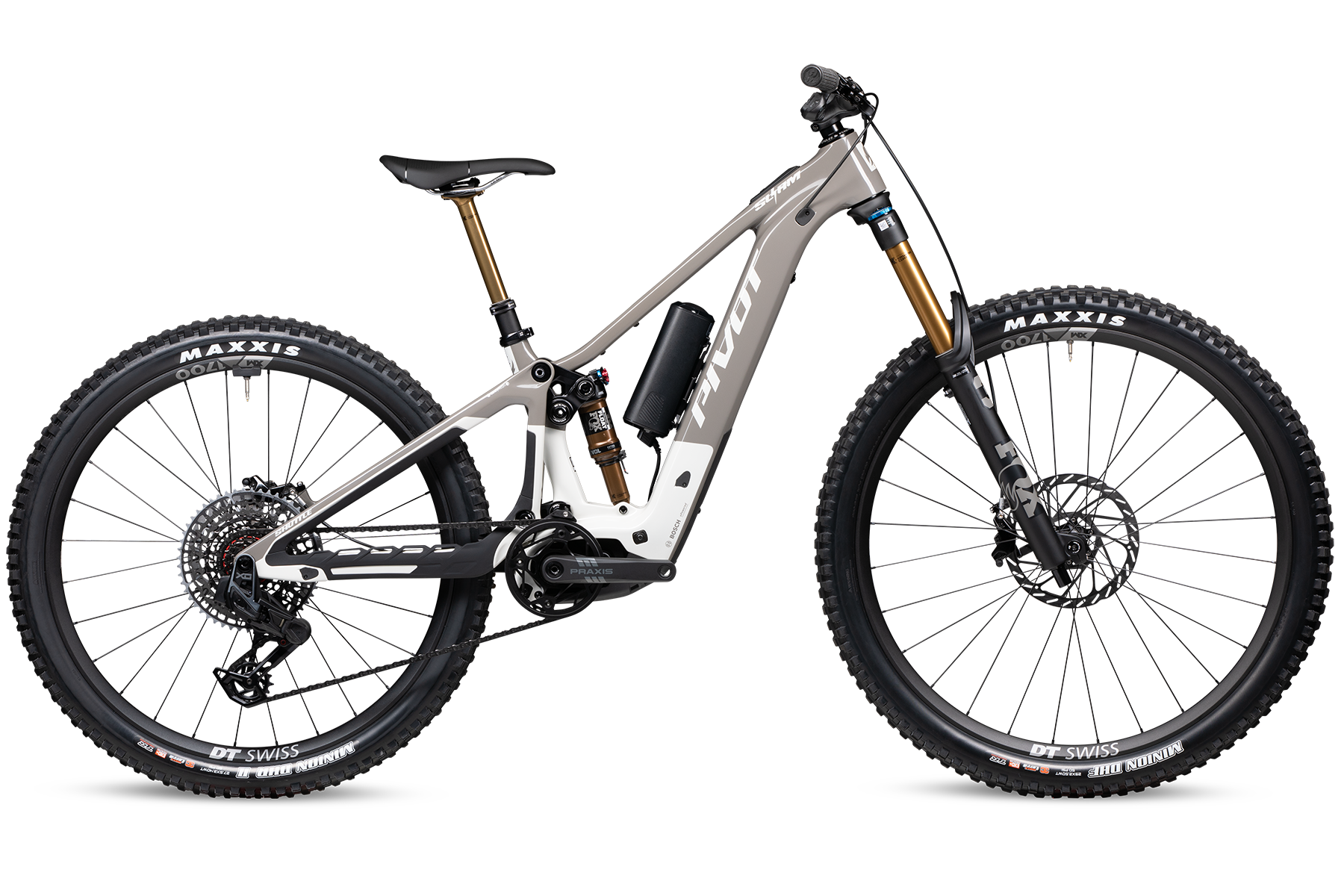
Not surprisingly, given that the SL/AM essentially uses the same frame as the Shuttle AM, the geometry numbers are very close, and we got along quite well with the geometry on the Shuttle AM. All sizes feature low standover heights, designed around the concept that the rider can choose their size based more on riding style than actual rider proportions.
Somewhat bucking an industry trend, Pivot keeps the chainstay length (444 mm) consistent throughout the size range. Considering there is a new XS size, and especially since it is a mullet, that is an interesting decision. With that said, 444 mm is neither on the short nor long side, but my guess is our editors up in the PNW would prefer to see a bit more length on the larger sizes for the super steep riding they do up there.
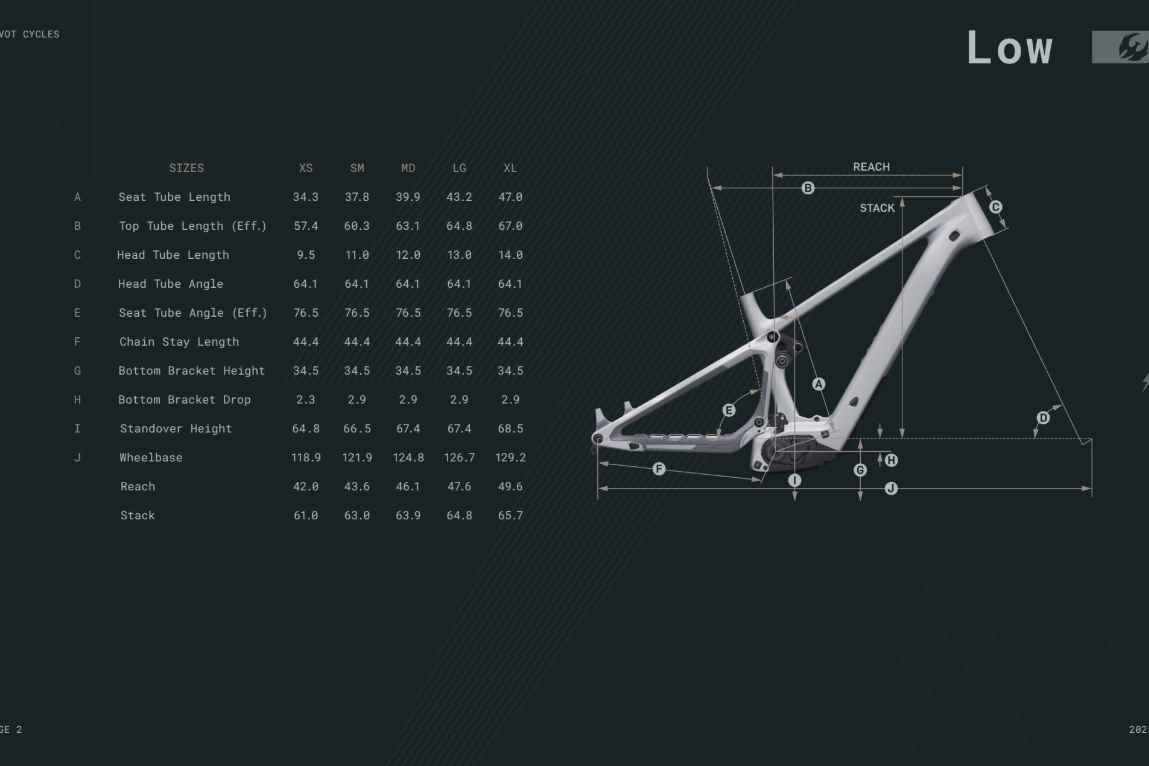
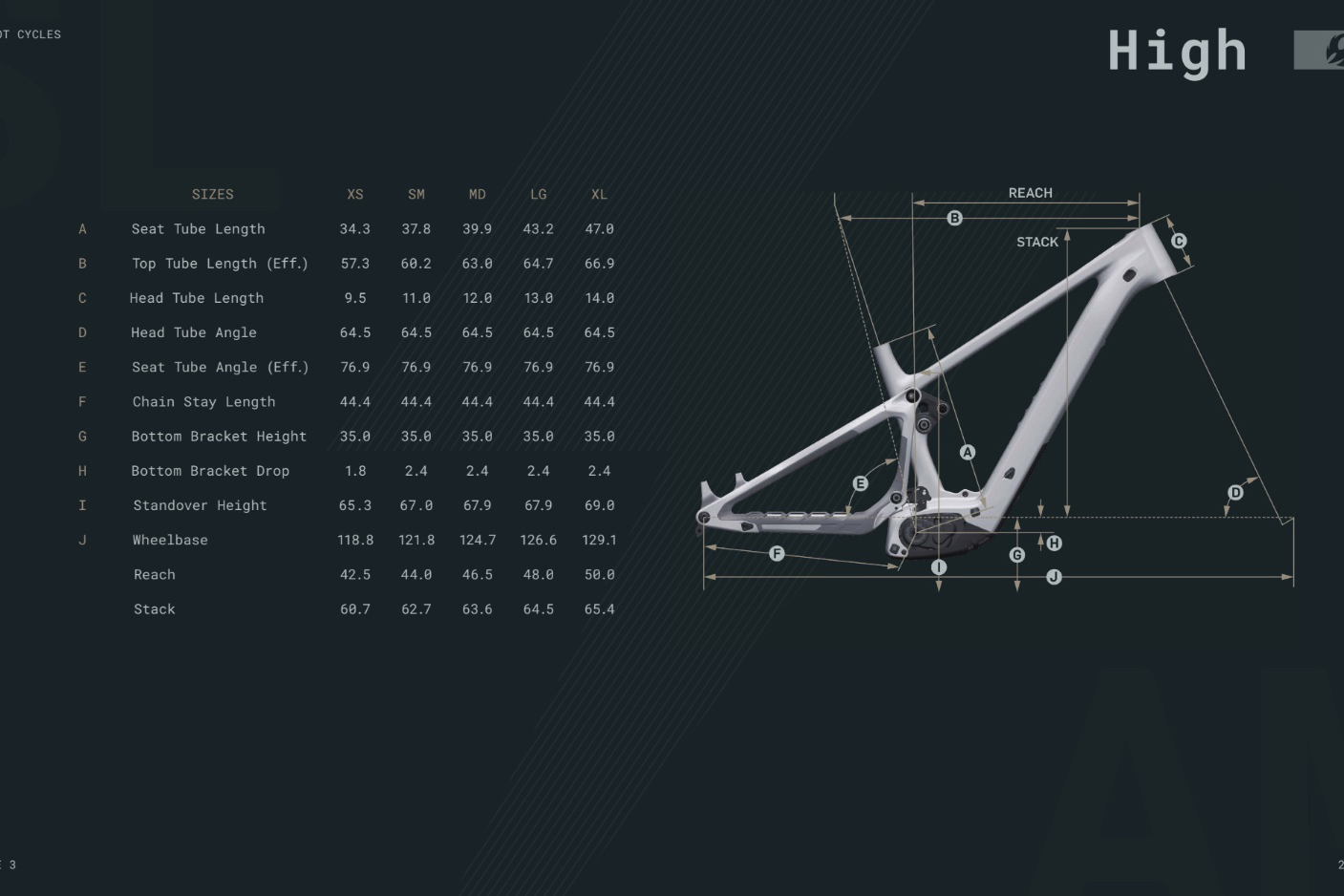
The Builds
Pivot offers the Shuttle SL/AM in three builds with a price range of $7,999 to $12,999. Pivot states that the Pro builds are the most popular option on their other models, and strike a nice balance between performance and price. Still, at $10,399, it’s a sizable investment, and if that’s not in the budget, saving $2,401 for the Eagle 70/90 is a good option. It is a solid build that trims a little bit of expense off many of the parts rather than dropping one specific component way down in level. Plus, SRAM just released an GX Transmission upgrade kit for Eagle 70/90 mechanical drivetrains, so wireless shifting could be an easy future upgrade. The Pro XO build, on the other hand, is very much a no-compromise build, with, in my opinion, nothing that warrants an upgrade, so there’s a case to simply get what you want from the start, too.
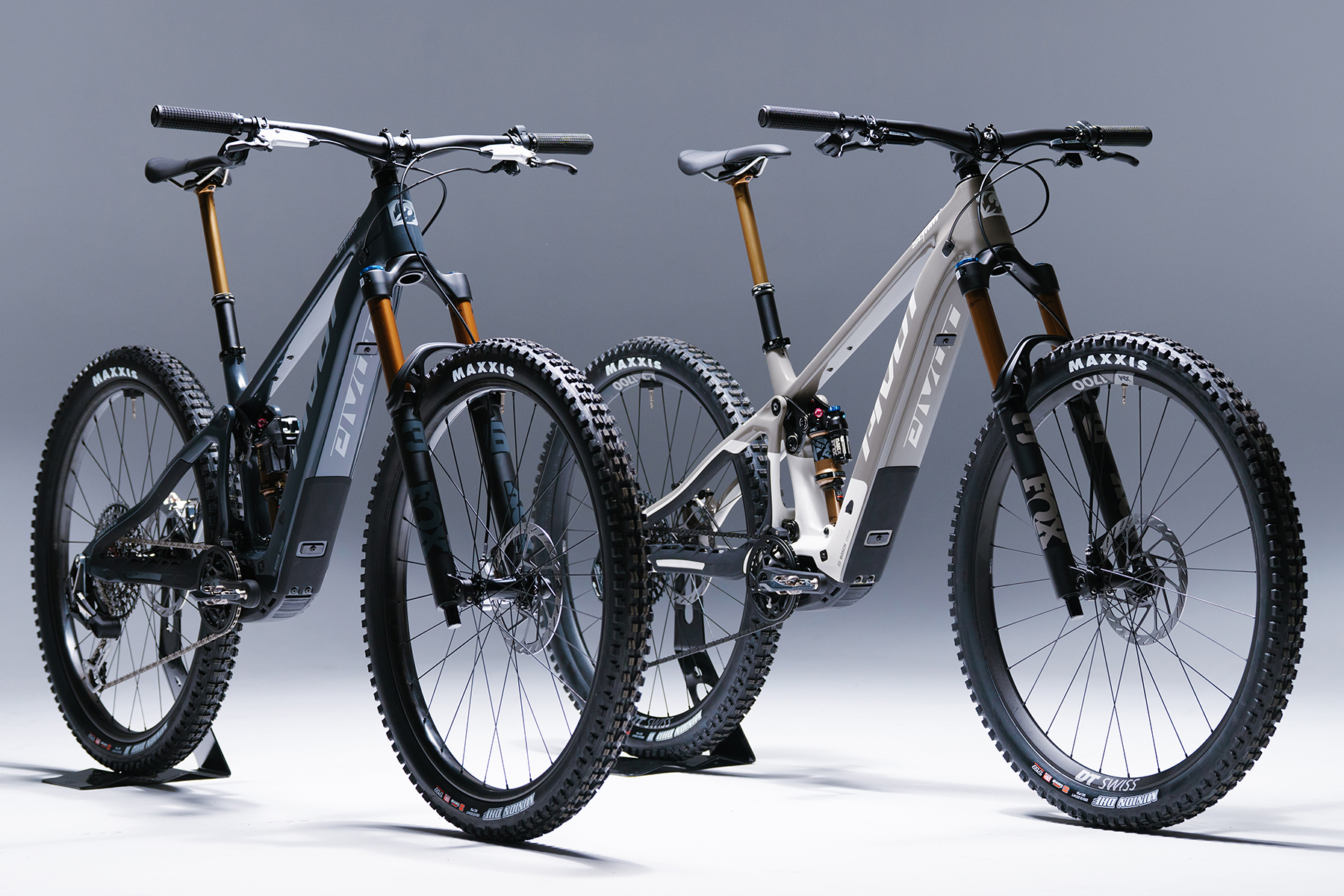
- Drivetrain: SRAM Eagle 90 Shifter/Derailleur with SRAM Eagle 70 cassette and chain
- Motor: BoschPerformance Line SX
- Battery: 400 Wh
- Fork: Fox 36
- Performance (160 mm)
- Shock: Fox Float Performance (XS), Fox Float X Performance (SM-XL)
- Brakes: SRAM DB8 Stealth w/ 200 mm rotors
- Wheels: DT Swiss Hybrid H1900
- Dropper Post: TranzX YSP23GLS (XS-SM: 130-150 mm; MD: 150-170 mm; LG-XL: 180-200)
- Drivetrain: SRAM Eagle 90 Shifter/Derailleur with SRAM Eagle 70 cassette and chain
- Motor: BoschPerformance Line SX
- Battery: 400 Wh w/ 250 Wh Range Extender
- Fork: Fox 36
- Performance (160 mm)
- Shock: Fox Float Performance (XS), Fox Float X Performance (SM-XL)
- Brakes: SRAM DB8 Stealth w/ 200 mm rotors
- Wheels: DT Swiss Hybrid H1900
- Dropper Post: TranzX YSP23GLS (XS-SM: 130-150 mm; MD: 150-170 mm; LG-XL: 180-200)
- Drivetrain: SRAM XO Eagle Transmission
- Motor: Bosch Performance Line SX
- Battery: 400 Wh
- Fork: Fox 36 Factory (160 mm)
- Shock: Fox Float Factory (XS), Fox Float X Factory (SM-XL)
- Brakes: SRAM Motive Silver w/ 200 mm rotors
- Wheels: DT Swiss XM1700
- Dropper Post: Fox Transfer Factory (XS-SM: 125-150 mm; MD: 155-180 mm; LG-XL: 185-210 mm)
- Drivetrain: SRAM XO Eagle Transmission
- Motor: Bosch Performance Line SX
- Battery: 400 Wh w/ 250 Wh Range Extender
- Fork: Fox 36 Factory (160 mm)
- Shock: Fox Float Factory (XS), Fox Float X Factory (SM-XL)
- Brakes: SRAM Motive Silver w/ 200 mm rotors
- Wheels: DT Swiss XM1700
- Dropper Post: Fox Transfer Factory (XS-SM: 125-150 mm; MD: 155-180 mm; LG-XL: 185-210 mm)
- Drivetrain: SRAM XO Eagle Transmission
- Motor: Bosch Performance Line SX
- Battery: 400 Wh
- Fork: Fox 36 Factory (160 mm)
- Shock: Fox Factory Float X Neo Live(Only offered on SM-XL)
- Brakes: SRAM Motive Silver w/ 200 mm rotors
- Wheels: DT Swiss XM1700
- Dropper Post: Fox Transfer Factory (XS-SM: 125-150 mm; MD: 155-180 mm; LG-XL: 185-210 mm)
- Drivetrain: SRAM XX Eagle Transmission
- Motor: Bosch Performance Line SX
- Battery: 400 Wh
- Fork: Fox 36 Factory (160 mm)
- Shock: Fox Float Factory (XS), Fox Float X Factory (SM-XL)
- Brakes: SRAM Motive Ultimate w/ 200 mm rotors
- Wheels: Reynolds Blacklabel Trail Pro w/ Industry Nine hubs
- Dropper Post: Fox Transfer Factory (XS-SM: 125-150 mm; MD: 155-180 mm; LG-XL: 185-210 mm)
- Drivetrain: SRAM XO Eagle Transmission
- Motor: Bosch Performance Line SX
- Battery: 400 Wh w/ 250 Wh Range Extender
- Fork: Fox 36 Factory (160 mm)
- Shock: Fox Factory Float X Neo Live(Only offered on SM-XL)
- Brakes: SRAM Motive Silver w/ 200 mm rotors
- Wheels: DT Swiss XM1700
- Dropper Post: Fox Transfer Factory (XS-SM: 125-150 mm; MD: 155-180 mm; LG-XL: 185-210 mm)
- Drivetrain: SRAM XX Eagle Transmission
- Motor: Bosch Performance Line SX
- Battery: 400 Wh w/ 250 Wh Range Extender
- Fork: Fox 36 Factory (160 mm)
- Shock: Fox Float Factory (XS), Fox Float X Factory (SM-XL)
- Brakes: SRAM Motive Ultimate w/ 200 mm rotors
- Wheels: Reynolds Blacklabel Trail Pro w/ Industry Nine hubs
- Dropper Post: Fox Transfer Factory (XS-SM: 125-150 mm; MD: 155-180 mm; LG-XL: 185-210 mm)
- Drivetrain: SRAM XX Eagle Transmission
- Motor: Bosch Performance Line SX
- Battery: 400 Wh
- Fork: Fox 36 Factory (160 mm)
- Shock: Fox Factory Float X Neo Live(Only offered on SM-XL)
- Brakes: SRAM Motive Ultimate w/ 200 mm rotors
- Wheels: Reynolds Blacklabel Trail Pro w/ Industry Nine hubs
- Dropper Post: Fox Transfer Factory (XS-SM: 125-150 mm; MD: 155-180 mm; LG-XL: 185-210 mm)
- Drivetrain: SRAM XX Eagle Transmission
- Motor: Bosch Performance Line SX
- Battery: 400 Wh w/ 250 Wh Range Extender
- Fork: Fox 36 Factory (160 mm)
- Shock: Fox Factory Float X Neo Live(Only offered on SM-XL)
- Brakes: SRAM Motive Ultimate w/ 200 mm rotors
- Wheels: Reynolds Blacklabel Trail Pro w/ Industry Nine hubs
- Dropper Post: Fox Transfer Factory (XS-SM: 125-150 mm; MD: 155-180 mm; LG-XL: 185-210 mm)
Some Questions / Things We’re Curious About
(1) How noticeable will the lower weight be when comparing the Shuttle SL/AM to the Shuttle AM?
(2) Will the addition of the range extender allow the Shuttle SL/AM to match full-power eMTBs in range?
3) The Shuttle SL/AM is essentially a lighter-weight, lower-powered Shuttle AM. Does it differentiate itself enough to offset the reduction in torque and range, or is the Shuttle AM still a better choice for most riders?
4) How will the Shuttle SL/AM compare to the Santa Cruz Vala, which has the Bosch full-power CX motor, a 600 Wh battery, and weighs 46.39 lbs (size Large)?
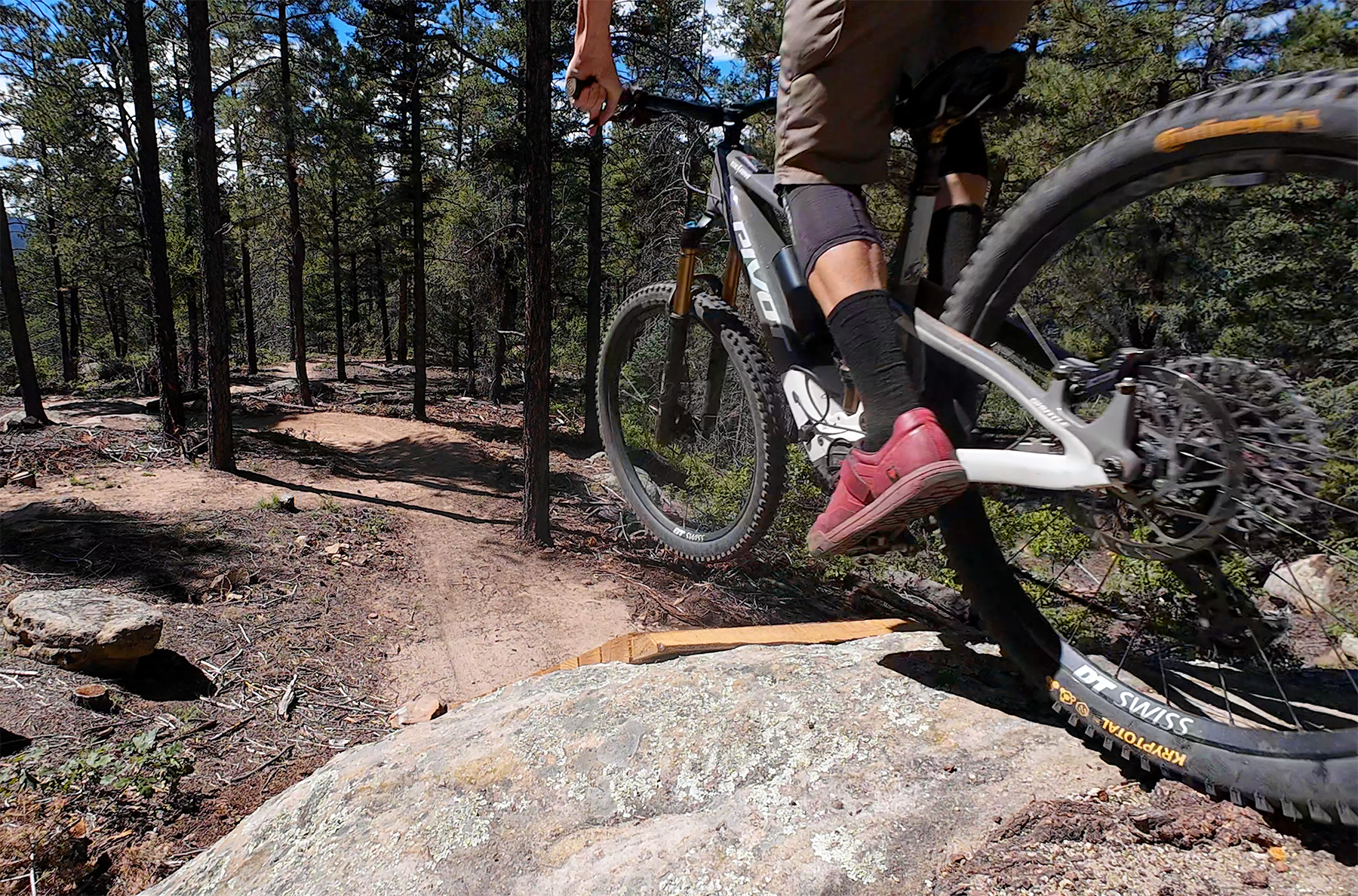
FULL REVIEW
Our experiences with Pivot’s Shuttle SL and Shuttle AM have been quite positive, with the SL being a great take on a lightweight, sporty, playful eMTB, and the Shuttle AM being a versatile and capable full-power one. So, what happens when you blend the two and produce a bike with similar weight and power output to the Shuttle SL but the same suspension travel and similar geometry as the Shuttle AM? We put hundreds of miles on the Pivot Shuttle SL/AM to find out.

Fit and Sizing
Dylan Wood (5’10.5”, 160 lbs / 179 cm, 72.5 kg): I’ve gotten along quite well with the fit of several of Pivot’s Large mountain bikes over the years, and the same is true of the Shuttle SL/AM.
Pivot’s recommended sizing for the Large Shuttle SL/AM puts me in the overlapping region between the Medium and Large frames, and that was borne out on trail — I got along well with the fit of our Large review bike, but could see myself sizing down to the Medium if I found myself riding tighter, steeper terrain more often. More on that in a minute.
The fit of the SL/AM feels pretty standard and straightforward, in a good way. Upon setting the seat height and lowering the handlebars to my preferred stack height, the Large Shuttle SL/AM’s fit already felt quite comfortable
Simon Stewart (6’, 170 lbs / 183 cm, 77 kg): Like Dylan, I also slot into Pivot’s recommended range (5’10’’–6’2’’) for the size Large, although I’m dead in the middle, whereas Dylan is on the bottom end. I like that while Pivot offers a size chart for reference, they recommend visiting a dealer and actually getting on the bike for a professional fit, and also suggest factoring in riding style into the sizing decision. In my case, I had already put a ton of miles on the identically sized Shuttle AM and found the fit to be just about perfect, so I was confident the size Large was the right choice for me.
Being a hair taller than Dylan, but with a very similar seat height, we have different fit preferences. For example, I prefer higher stack heights than Dylan does, and when we switch bikes, we often complain about the other’s stem height. Lucky for Dylan, I found the Shuttle SL/AM’s healthy 643 mm stack height to put my hands in a comfortable position without having to resort to a higher-rise handlebar, which made it easier for us to swap back and forth on the bike just by moving headset spacers.
Overall, I find the fit of the size Large Shuttle SL/AM to be spot on for me, and unlike Dylan, I’m not tempted to size down to the Medium when riding steeper, more technical terrain.

Climbing
Dylan: Mixing efficient suspension with a small-but-mighty Bosch SX motor, the Shuttle SL/AM is a very good climbing eMTB. It doesn’t have the all-out power of its full-power counterpart, the Shuttle AM, but especially given its weight, the Shuttle SL/AM is very impressive on the uphill.
Pivot’s DW-link suspension design is renowned for its efficiency and responsiveness, and these qualities carry over to their Shuttle SL/AM eMTB. This bike has an inherently sprightly suspension feel, with much of the power delivered to the pedals resulting in direct forward movement of the bike. Add Bosch’s SX motor system, with its class-defying 600 watts of peak power, and the Shuttle SL/AM is very quick to accelerate uphill and can sustain a fast climbing pace.
And while it is no class leader when it comes to traction, the Shuttle SL/AM has just enough grip on the way up to justify the fact that it has a motor, but not so much to take away from Pivot’s signature DW-link suspension feel. While more planted eMTBs like the Yeti MTe stay glued to the trail a bit better when things get loose and steep, the Shuttle SL/AM provides especially sharp pedaling response, with enough pedal assist to propel you up climbs at pretty ridiculous speeds for the light-assist class.
Simon: I’m in complete agreement with Dylan that the Shuttle SL/AM’s pedaling efficiency and responsiveness stand out. Pedaling efficiency often isn’t considered an important metric for eMTBs in general, which is understandable, since having a motor can make even a long-travel Enduro sled feel as fast as an XC race bike. However, while that is mostly true for Full-Power eMTBs, once you start looking at Light-Assist eMTBs, having good pedaling efficiency is noticeable and welcome, since the lower output from light-assist motors encourages the rider to add more of their own watts.
I thoroughly enjoyed turning myself inside out riding the Shuttle SL/AM, and found myself pinning it on just about every ride. The Bosch SX drive system prefers a high cadence in the 100 rpm range to really extract all of its assist potential, and thanks to the sporty nature of the Shuttle SL/AM’s suspension, pushing hard and fast on the pedals rewards the rider with impressive speed. I often tell eBike-curious folks that you can bury yourself on an eMTB just like you can on a non-motorized bike, and the Shuttle SL/AM is a great example of an eMTB that rewards hard pedaling and encourages the rider to do just that.
Like most of the other Light-Assist eMTBs I’ve tested, the Shuttle SL/AM lacks the outright power to tackle super steep, heinously technical climbs. There’s just a point where, despite maxing out my own power contribution, you simply run out of power. Additionally, the higher cadence necessary to get all the beans out of the Bosch SX motor isn’t particularly well-suited to climbing these types of trails. If seeking out these kinds of climbs is a priority, Full-Power eMTBs are a better option. With that said, the Shuttle SL/AM didn’t embarrass itself either, and its combination of lightweight with an active suspension and the punchy SX motor put in a pretty good showing.
I found the Shuttle SL/AM’s lightweight to be an asset when negotiating slow technical moves, making it easier to move it around and lift the front end up over rocks and ledges. Here, the active rear suspension does a nice job of staying composed and doesn’t wallow into its travel during pronounced weight shifts.

Descending
Dylan: The Shuttle SL/AM manages to be both pretty playful and engaging, while still being fairly capable on more challenging descents.
With a light chassis and relatively lively DW-link suspension, the Shuttle SL/AM is fairly easy to get airborne. And while 444 mm chainstays are a bit long by Pivot’s standards, they are a touch on the shorter end for mid-travel eMTBs these days, furthering this bike’s poppy feel. Additionally, the Shuttle SL/AM corners great, with the short-ish chainstays facilitating a snappy feel in tight turns. Overall, the Shuttle SL/AM is a playful bike, and while it doesn’t quite match the super quick handling of the Shuttle SL, it’s still relatively responsive and nimble for its class.
But I wouldn’t pigeonhole the SL/AM as just being a playful, nimble bike to the exclusion of other traits, either. After testing its all-out speed and downhill capability on some steep, fast, and demanding trails, the Shuttle SL/AM’s ability to make quick work of descents really made me rethink exactly where this bike fits in the broader eMTB landscape.
The Shuttle SL/AM’s suspension balances traction and liveliness quite well. On fast, chunky descents, it can be ridden very hard, with its limits only being found at the top 5-10% of how hard a mortal like myself can ride a mountain bike. With stable steering, a generous wheelbase, and not-crazy-short chainstays, the Shuttle SL/AM’s geometry is pretty conducive to riding fast and hard, too. This certainly isn’t the most traction-rich mountain bike out there — the Shuttle SL/AM does require some calculated line selection and good timing of weighting and unweighting the bike to go fast over rough terrain, rather than sitting back and letting the bike do the work.
While not available as a stock option, the Shuttle SL/AM is compatible with a smaller 27.5” rear wheel when run in the “Hi” geometry setting. And, the extra playfulness and snappy feeling you get from a mullet setup really complements the Shuttle’s already playful nature. I personally enjoyed it most in this setting, especially on flowy trails and steep chutes where I appreciated some extra tush-to-tire clearance. The ability to run this bike as a mullet even furthers the Shuttle SL/AM’s versatility, with it traversing rough terrain a bit more efficiently with two 29” wheels, and it feels more maneuverable and zippy as a mullet.
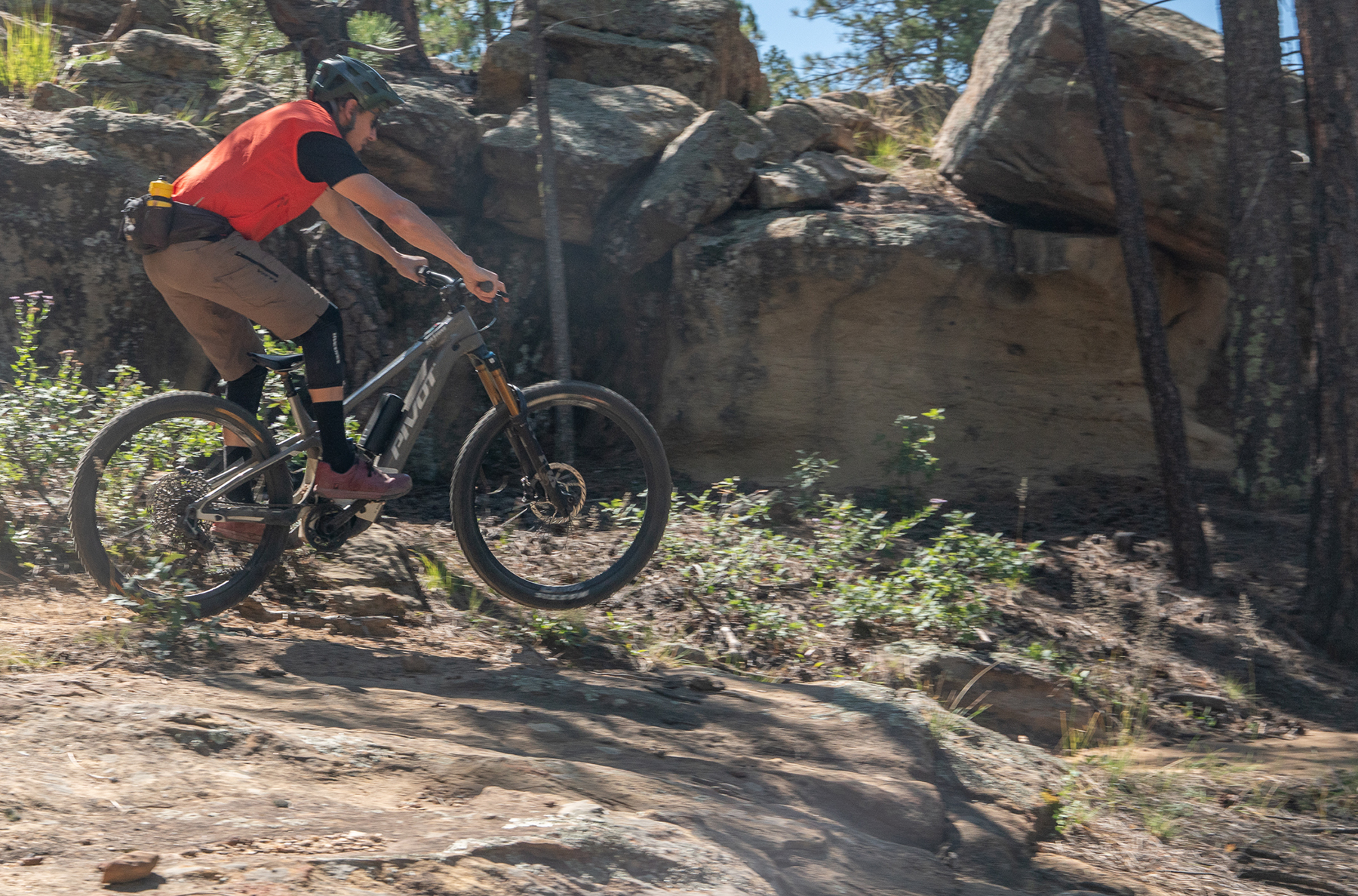
Simon: Given the Shuttle SL/AM has identical geometry to the Shuttle AM (which impressed us with its descending performance), but weighs about 8 Ib / 3.63 kg less, I was very curious how that would translate on trail. Well, the Shuttle SL/AM is noticeably poppier and more playful; it’s also easier to get the front end up in a manual, likely thanks to the lighter battery in the downtube. Aside from that, it feels quite similar to the Shuttle AM, and overall, I agree with Dylan’s take on how it descends.
In the 29er configuration, I settled on the “Lo” geometry setting as my preference and spent most of my time there. I find little difference in crank clearance in the “Lo” setting, nor do I find the slightly slacker seat tube angle holds it back when climbing, but I do appreciate the slacker head angle when descending steep terrain. However, once I tried it as a mullet (with the flip chip in the “Hi” position), it became my favorite setup because I think it complements the Shuttle SL/AM’s playful personality perfectly. Plus, I’m generally a fan of mullets on eMTBs anyway, so it fits my preferences nicely, and I don’t find any real negatives to speak of. Like the rest of Pivot’s eMTB lineup, the Shuttle SL/AM uses 157 mm rear axle spacing, so keep that in mind when shopping for a 27.5” rear wheel.
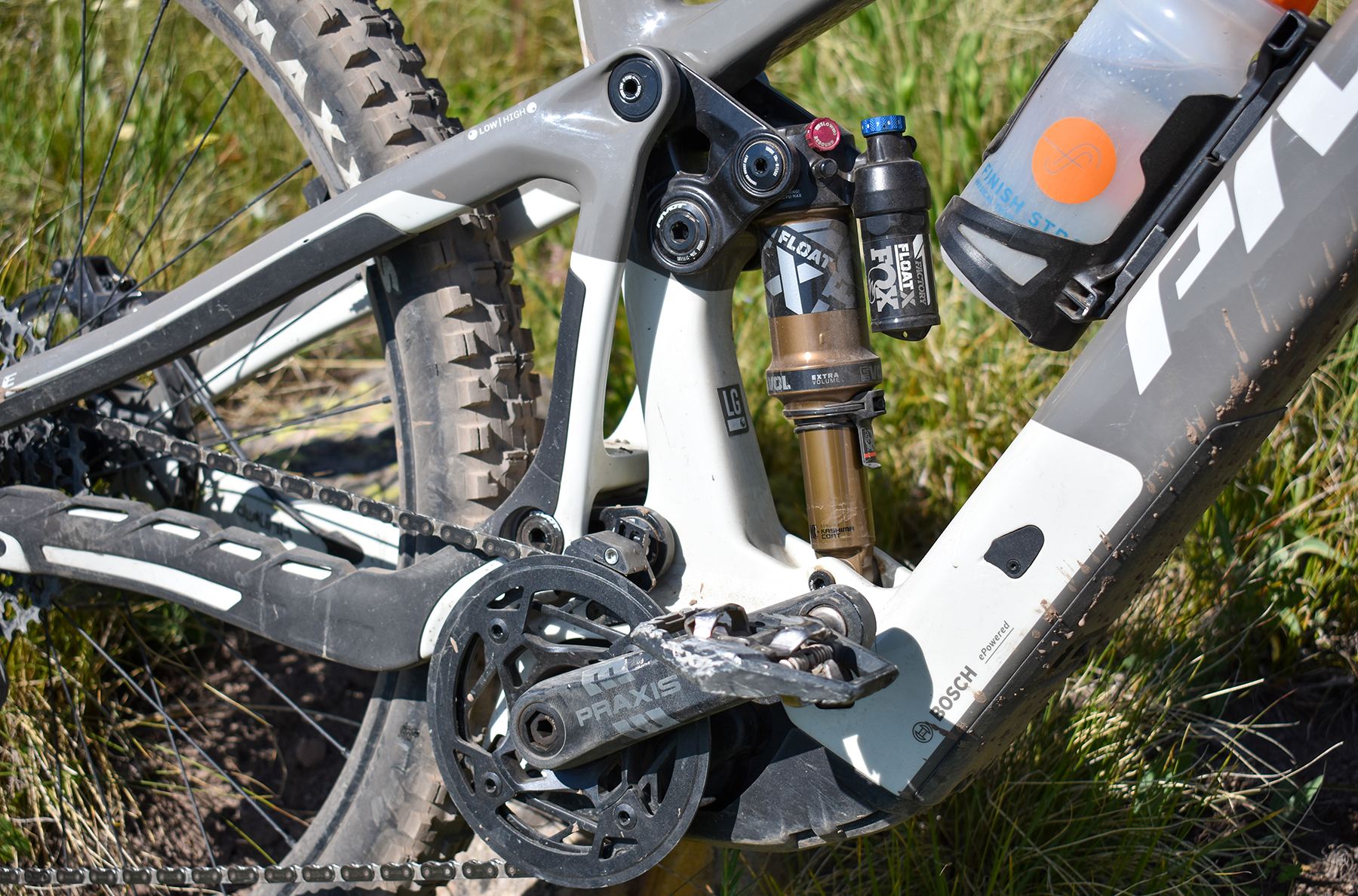
Drive System and Range
Dylan: This is the third eMTB I’ve tested with Bosch’s Performance Line SX drive system. Overall, my impressions from the Norco Fluid VLT 130 and Mondraker Dune XR mostly carry over to the SL/AM, though it’s worth mentioning that I did not experience the assist level tapering off 15-20 minutes into a climb as I did on the Dune XR.
With a 400 Wh battery, the Shuttle SL/AM has a fine, but not exceptional, range. I couldn’t get more than ~20 miles and ~4,000 feet of elevation gain out of it while running the standard Turbo mode. However, the Shuttle SL/AM’s range capability is greatly improved when adding Bosch’s Powermore 250 range extender. With this 62.5% increase in watt-hours, the length and vert of rides you can do on the Shuttle SL/AM increases significantly. With the range extender added, I was able to eke out about 30 miles and 5,000 feet of elevation gain aboard this bike in turbo mode before draining its battery. For reference, I did the same ride on an eMTB with Bosch CX and an 800 Wh battery, and while also using turbo mode, I had to begin conserving the battery near the end of the ride to not run out of assist. Granted, I did complete the ride 30 minutes faster aboard the full-power eMTB.
So, the Shuttle SL/AM has a respectable range for its class, but I see adding the Powermore 250 as almost a necessity on this bike. With a range extender and time spent away from the highest few assist levels, all-day epics are certainly possible on this bike.
Simon: I’ve grown quite fond of Bosch’s SX drive system. I love that you have to put in a good bit of your own effort to extract maximum power out of it, which I think complements and adds to the Shuttle SL/AM’s engaging personality.
I agree with Dylan that the range extender feels more like a necessity than an optional accessory. Without it, the Shuttle SL/AM is pretty range-limited when ridden in its higher assist modes, like Turbo and eMTB+. I’m going to generalize a bit by saying that the majority of riders spend most of their time in the higher assist settings, which isn’t without basis, as the folks at Bosch have shared data with me showing most riders spend nearly all of their time in Turbo mode. It looks like Pivot agrees, since they now offer builds that come with the range extender from the factory.
Additionally, it’s worth noting that Bosch has recently released a firmware update that increases the SX motor’s assist percentage from 340% to 400%, and torque output goes up to 60 Nm from 55 Nm. The added performance, while fairly small on paper, does make an appreciable difference on the trail. It feels more torquey taking off from a standstill, and the 600 watts of peak power feels more accessible from a lower cadence than was necessary before the update. In short, the spunky little light-assist motor is now even spunkier, and likely a little thirstier when it comes to battery consumption, too.
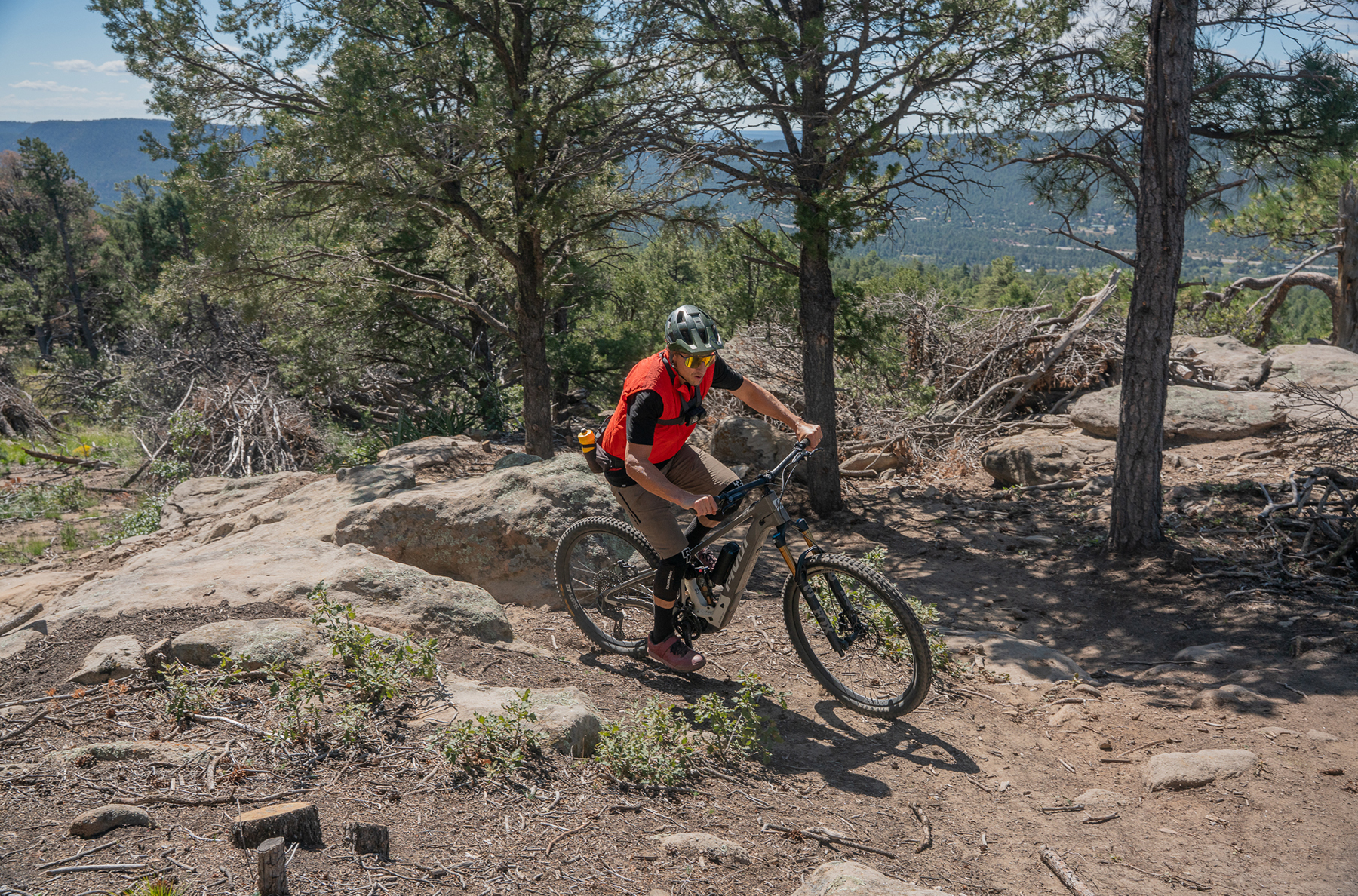
The Build
Dylan: The Pro X0 Transmission build kit we tested was great, and just a step away from being excellent.
Fox Factory suspension is a highlight on this bike. With a stiff and smooth 36 fork up front and a well-balanced Float X out back, I have no complaints regarding the suspension components on this bike. And per usual, the SRAM X0 Transmission drivetrain was a great fit for this motor-assisted mountain bike, with smooth, consistent shifts up and down the cassette, even under power.
My only real quarrel here is with the SRAM Motive brakes spec’d on this bike. While not as thoroughly undergunned as, say, the SRAM Level brakes we had to deal with on the Norco Fluid VLT 130, the Motive brakes on the Shuttle SL/AM were simply no match for the pace and aggression an eMTB makes possible. I had to be sure to brake earlier than usual on this bike to shed speed before a tight corner or check up before a steep section. Swapping over from a bike equipped with stronger brakes always made for a brief adjustment period of a few corners on the way down before I remembered how the Shuttle SL/AM’s brakes require a more cautious approach. I get that Pivot had a weight goal with this eMTB, but to me, brakes are not the place to save grams. It certainly didn’t ruin my experience aboard the Shuttle SL/AM, but it did keep this great eMTB from being excellent.
Simon: Like Dylan, I found the Pro XO Transmission build to be mostly spot on, and share the same sentiment about the brakes. I may not have disliked them as much as Dylan, but I agree that they are not very well matched to the capabilities of the Shuttle SL/AM. I generally advocate for the most powerful brake option available for eMTBs because they are heavy in comparison to non-powered bikes, regardless of whether they are light-assist or not, plus you end up using the brakes more due to the higher speeds that are attainable when on flat and undulating terrain.
I mentioned above that Pivot now offers builds with a range extender included, and all of their build levels have a range extender option. I recommend choosing a build with the range extender, as it significantly increases the Shuttle SL/AM’s range and overall versatility.

Who’s It For?
Dylan: The Shuttle SL/AM really impressed me with how playfully it rode without feeling limited on steeper, rougher terrain. It provides a familiar descending experience for folks who are coming from the unmotorized world, with great maneuverability and no moments of sluggishness. At the same time, it can be ridden really hard on demanding descents, especially for more dynamic riders who like to be precise and smooth rather than those who like to treat their eMTB like a bulldozer. Add one of the most powerful light-assist systems, and you have a really responsive eMTB that makes many different types of terrain enjoyable and should appeal to riders after a more natural feeling, responsive, lightweight eMTB.
Simon: I’ll add that riders who ride XS small bikes, and who likely haven’t had the easiest time finding eMTBs in that size, should take a look at the Shuttle SL/AM. It not only comes in a size XS, but its low weight (our review bike weighed 42.8 lbs / 19.4 kg for a size Large) gives it a light-on-its-feet feel that should make it easier to move around for smaller-sized riders.
Also, I think when considering an eMTB, it’s important to factor in what your buddies are riding, and thanks to the Shuttle SL/AM’s lightweight and pedaling efficiency, combined with the feisty SX motor, I think folks can ride it with friends on Full-Power eMTBs without getting left behind.

Bottom Line
Pivot’s goal was to offer an eMTB that strikes a middle ground between their Shuttle SL and Shuttle AM by merging the lightweight and athletic qualities of the Shuttle SL, with the longer travel and descending capability of the Shuttle AM. We think they nailed it. Is it better than either of them? “Better” is pretty subjective, and the real question is which eMTB best suits your needs, but the Shuttle SL/AM offers another outstanding option in the already very accomplished Shuttle eMTB lineup.
Deep Dive Comparisons
BLISTER+ members and those who purchase our Digital Access Pass can check out our Deep Dive comparisons linked below. Get our Digital Access Pass to view all our Deep Dives and Flash Reviews, or become a BLISTER+ member today to get access to that and a LOT more, including the best worldwide Outdoor Injury Insurance, exclusive deals and discounts on skis, personalized gear recommendations from us, and much more.

Deep Dive: Pivot Shuttle SL/AM
We compare the Pivot Shuttle SL/AM to the Pivot Shuttle SL, Rocky Mountain Instinct Powerplay SL, Canyon Spectral:ONfly, Santa Cruz Heckler SL, Mondraker Dune XR, Yeti MTe, and Propain Sresh SL
Blister’s Flash Reviews and Deep Dives are accessible to those who purchase one of our paid subscriptions
To get our comprehensive Deep Dives and our initial, unfiltered reports on new gear, become a member and receive many other services, deals, and discounts.
If you’re already an active member, please log in.
(If you’re already logged in and a member in good standing and seeing this message in error, please refresh this page in your browser.)
